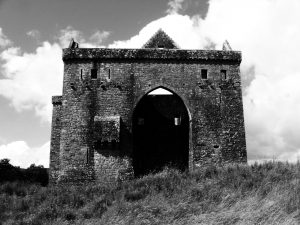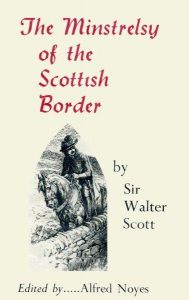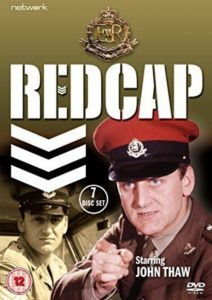Dark folklore and verse today, dear listener. We travel up to the Scottish borders, visit American poet Frank Coffman, by strange association, and then swing back for a legend of Holderness in Yorkshire. We unveil an exclusive folklore/folk horror ballad on the wicked redcap by Frank in the process, and even add in a short ballad by Paul St John Mackintosh.

Some of you may already know of the redcap, or Robin Redcap. The folklorist William Henderson (1813-1891) described this malevolent, goblin-like being in detail:
“Redcap, Redcomb, or Bloody Cap, is a sprite of another sort from the friendly Brownie. He is cruel and malignant of mood, and resides in spots which were once the scene of tyranny — such as Border castles, towers, and peelhouses. He is depicted as a short thickset old man, with long prominent teeth, skinny fingers armed with talons like eagles, large eyes of a fiery-red colour, grisly hair streaming down his shoulders, iron boots, a pikestaff in his left hand, and a red cap on his head. When benighted or shelterless travellers take refuge in his haunts, he flings huge stones at them; nay, unless he is much maligned, he murders them outright, and catches their blood in his cap, which thus acquires its crimson hue.
“This ill-conditioned goblin may, however, be driven away by repeating Scripture words, or holding up the Cross ; he will then yell dismally, or vanish in a flame of fire, leaving behind him a large tooth on the spot where he was last seen.”
Notes on the Folk-lore of the Northern Counties of England and the Borders (1879)
And Sir Walter Scott mentions the creature in his Minstrelsy of the Scottish Border:
“Redcap is a popular appellation of that class of spirits which haunt old castles. Every ruined tower in the south of Scotland is supposed to have an inhabitant of this species.”
Perhaps the most famous citation of the redcap is in the ballad collected by John Leyden (1775 – 1811), a Scots folklorist and orientalist. ‘Lord Soulis’ was passed to Scott and included in Volume Three of Minstrelsy – it’s long, but we’ll give you a taste:
Lord Soulis
by J Leyden
Lord Soulis he sat in Hermitage castle,
And beside him Old Redcap sly;—
“Now, tell me, thou sprite, who art meikle of might,
“The death that I must die?”
“While thou shalt bear a charmed life,
“And hold that life of me,
“‘Gainst lance and arrow, sword and knife,
“I shall thy warrant be.
“Nor forged steel, nor hempen band,
“Shall e’er thy limbs confine,
“Till threefold ropes, of sifted sand,
“Around thy body twine.
“If danger press fast, knock thrice on the chest,
“With rusty padlocks bound;
“Turn away your eyes, when the lid shall rise,
“And listen to the sound.”
Minstrelsy of the Scottish Border (1806)
Historically, the real William de Soulis, Lord of Liddesdale, shifted sides between the English and the Scots, and the official record is that he was eventually imprisoned at Dumbarton at the order of King Robert of Scotland (Robert the Bruce), dying in or by 1321. A number of Border Ballads are a mixture of fact and fiction, and there’s a degree of confusion and myth-making when it comes to William.
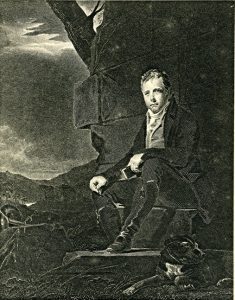
Sir Walter Scott says, of this Lord Soulis:
“…he is represented as a cruel tyrant and sorcerer; constantly employed in oppressing his vassals, harassing his neighbours, and fortifying his castle of Hermitage against the king of Scotland; for which purpose he employed all means, human and infernal: invoking the fiends, by his incantations, and forcing his vassals to drag materials, like beasts of burden. Tradition proceeds to relate, that the Scottish king, irritated by reiterated complaints, peevishly exclaimed to the petitioners, “Boil him, if you please, but let me hear no more of him.”
“Satisfied with this answer, they proceeded with the utmost haste to execute the commission; which they accomplished, by boiling him alive on the Nine-stane Rig, in a cauldron, said to have been long preserved at Skelf-hill, a hamlet betwixt Hawick and the Hermitage. Messengers, it is said, were immediately dispatched by the king, to prevent the effects of such a hasty declaration; but they only arrived in time to witness the conclusion of the ceremony.
“The castle of Hermitage, unable to support the load of iniquity, which had been long accumulating within its walls, is supposed to have partly sunk beneath the ground; and its ruins are still regarded by the peasants with peculiar aversion and terror. The door of the chamber, where Lord Soulis is said to have held his conferences with the evil spirits, is supposed to be opened once in seven years, by that dæmon, to which, when he left the castle, never to return, he committed the keys, by throwing them over his left shoulder, and desiring it to keep them till his return. Into this chamber, which is really the dungeon of the castle, the peasant is afraid to look; for such is the active malignity of its inmate, that a willow, inserted at the chinks of the door, is found peeled, or stripped of its bark, when drawn back.”
ibid
Hermitage Castle, which is in Liddesdale, right on the border with England, still exists today. Some believe the true fate of William de Soulis was mixed up with another of the line (possibly Ranulf de Soulis) who was supposed to have been slain by his servants.
Whether Ranulf was boiled alive or not, we cannot say. Nor can we prove that either Ranulf or William were sorcerors, unfortunately. As is the way of these things, the whole de Soulis dark magicks story is compounded by connections with Michael Scott, the legendary scholar who was later immortalised as a powerful wizard by… Sir Walter Scott.
TRIVIA 1: Robert Bruce, an illegitimate son of Robert the Bruce, was later acclaimed as Lord of Liddesdale, the de Soulis (or de Soules) line having forfeited the title.
TRIVIA 2: None of the above should be confused with the 1964 TV series Redcap, starring John Thaw, who later became the incarnation of Inspector Morse. That was named after the red caps of the British military police, who were not supposed to steep them in blood. Really.
COFFMAN AND THE REDCAP
Our musings on the redcap in general were re-awakened by Frank Coffman, writer, prolific poet and crafter of weird verse, who sent us this rather neat piece in response to an on-line discussion. We’ll say something about Frank’s latest collection in a moment, but first of all here’s the ballad he supplied, for its first ever showing:
Redcap
A Ballad of the Border Country, by Frank Coffman
Along the Tweed, an ancient row
Of stony ruins runs.
Grey-grim and stark, they fell below
Two-hundred thousand suns.
The years swept over tall peel towers,
Castles, and cairns for bone.
With trials of Time and Nature’s powers—
Their rubble sleeps alone.
And yet, not quite alone are they
Across that country wide,
From Berwick to the Tower of Wrae
And down to Cardrona side.
For there are wights about at nights
Among those fallen stones.
Within the ruined towers, strange lights
Are seen. A cold wind moans.
Long gone the days when watch fires blazed
Along that row of forts.
But, Traveler, you would be amazed,
For still a light—of sorts—
Can be seen if you dare to come too near
To those abandoned places.
And you’ll have every cause for fear
When you behold their faces!
They are those of the Unseely Court,
Gnomes you must rightly dread.
Flee for your life’s your best resort,
Or you will sure be dead!
They are Redcaps, each stands his guard
At those old fallen towers
And your spilt blood is their reward
If you fall ‘neath their powers.
He’s short, thick-framed, with long grey hair,
With razor-sharp, long nails.
If, in the night, you dare his lair,
And Scripture chanting fails;
Sometimes a Cross will send him gone,
Those iron boots will clank.
If you survive until the dawn,
You’ve surely God to thank.
Far better to beware. Don’t dare
Those old stones ‘neath the moon.
For there is Death residing there,
And it will come full soon.
For holy signs and Bible verse
Are rarely safe. Instead,
A fool falls victim to the curse;
Hurled stone will crush his head.
Sometimes, old Redcap’s halberd chops
And takes the head clean off.
Or spear-point rips out guts. He stops
And then his cap he’ll doff.
His name is true; his cap is red.
Made scarlet in its hue
By soaking blood spilled from the dead!
Most horrible to view!
‘Tis stained, but decked with grim black gouts,
Dried from his many kills.
When his foul fun is done, he shouts
To echo from the hills.
So heed my tale. Do not go near—
If you would keep your breath—
Those piles of stone bring more than fear;
You’ll likely meet your death.
Leave Redcap and his ilk alone.
Stay home—and lock your doors.
Let the night wind keen and moan
Through ruins fraught with horrors.
Which brings us nicely to Frank’s latest publication, This Ae Nighte, Every Nighte and Alle, a chapbook of thirty three short poems. You can read more about the title in the book itself, but suffice to say that it once more comes back to Yorkshire, for it draws on the Lyke Wake Dirge of our homeland.
It’s a lovely little book, beautifully laid out and even includes a glossary of poetical forms for those who are serious versifiers.
“This slim volume is presented as a sampling of some of my efforts in the rapidly reviving and burgeoning realms of both Formalist and Speculative poetry… The theme, focus, genre, subject of the several poems you’ll find in these pages is of the weirdly horrific and supernatural.”
A retired professor of college English, creative writing, and journalism, Frank has published poetry and fiction across speculative genres in magazines, anthologies, and online.
“Poetry scholar Frank Coffman creates a relentless and obsessive poetic journey into the dark night of the soul. Poet Coffman utilizes classic poetic forms such as the sonnet and villanelle in a postmodern, so-old-it-is-new way to unleash a speculative world of supernatural terror. These poems are just the thing to read aloud on Halloween, or if you want to make every day Halloween. He brings a lifetime of experience with him to create a volume that is both rigorous and enchanted.” —JP Bloch, author of Identity Thief and Shadow Language
“…he’s an expert on folklore themes and an impressive master of formal verse.” —Marge Simon, from her column, Blood And Spades, in the HWA Newsletter.
We’re also looking forward to a further volume from the Master. His major collection The Coven’s Hornbook and Other Poems (around 270 pp with poems and glossary of exotic types, and foreword by Donald Sidney-Fryer, “Foreword” by Frederick J. Mayer, and illustrations by Yves Tourigny) will be out in early 2019.
(Incidentally, Frank has a very evocative story – not a poem! – in the forthcoming anthology Hell’s Empire from Ulthar Press.)
This Ae Nighte, Every Nighte and Alle can be obtained via this link:
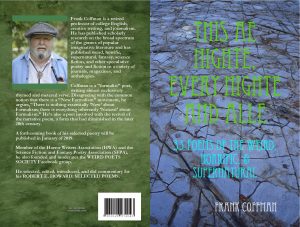 http://www.lulu.com/shop/frank-coffman/this-ae-nighte-every-nighte-and-alle/paperback/product-23781908.html
http://www.lulu.com/shop/frank-coffman/this-ae-nighte-every-nighte-and-alle/paperback/product-23781908.html
By one of those odd coincidences which regularly bless greydogtales, we are pleased to have at hand a new short ballad on the redcap theme from writer/poet Paul St John Mackintosh, who occasionally graces out pages with reviews and opinion pieces. What better place to show this off as well?
“The Redcap”
In Border haunts, the Redcap lurks
with iron boots and pike
among black ruins’ blasted stones
to slay those he can take.
His tall cap glistens thirstily
a bright and bloody red,
for if it were to dry dull brown
the Redcap would fall dead.
But Border burns run thick with blood
where many brave men die
and Redcap never will be short
of colour for his dye.
Paul’s latest review for greydogtales can be found here:
http://greydogtales.com/blog/trains-terror-grabinski-returns-niveau-triumphs/
Homeward Bound
At last, down from the Borders, along the path of the Lyke Wake Walk and to the North Sea Coast of Yorkshire again. Henderson also mentions in his Notes on the Folk-lore of the Northern Counties…
“There are Redcaps in Holland too, but they have little in common with the Scottish Redcap, except the name. They are nearer akin to the Brownie, whom they resemble in their attachment to certain homesteads, in the diligence with which they perform manual labour, and in their abrupt departure on receiving a guerdon in the form of clothing. The Dutch Redcaps light fires during the night, which are invisible save to themselves, but warm the house; and the few sticks they leave of the Hausfrau’s stock of brushwood serve her as long as a great bundle, and give double the warmth. They are clad in red from head to foot, and have green hands and faces.”
There has long been a Northern European influence on this part of the coast (we ourselves were called Danes by an old fellow when we moved to West Yorkshire, because of dialect and inflections). So here, to redcap or roundcap off the article, is a wry folk tale, from Holderness in East Yorkshire, where we run the lurchers often:
“The Hob Thrust, or Robin Round Cap, is a good natured fellow who assists servant maids by doing their work in the early morning. As he never wears clothes, it is told that one servant girl offered to make him a harden shirt (a shirt made of coarse, brown linen), but this gave him such offence that he instantly departed and never returned. Should he, however, have spite against any one, he annoys them terribly by breaking crockery, upsetting the milk, letting the beer run to waste, throwing down pans, rattling things together, and giving the place a reputation for being haunted.
“The Rev. W. H. Jones relates a story of a Holderness farmer who had his life made so miserable by one of these impish spirits that he determined to leave his farm. All was ready, and the carts, filled with furniture, moved away from the haunted house. As they went, a friend inquired ” Is tha flitting? ” and before the farmer could reply, a voice came from the churn, “Ay, we’re flitting!” and lo! there sat Robin Round Cap, who was also changing his residence. Seeing this, the farmer returned to his old home. By the aid of charms, Robin was enticed into a well, and there he is to this day, for the well is still called Robin Round Cap Well.”
John Nicolson’s Folk Lore of East Yorkshire (1890)
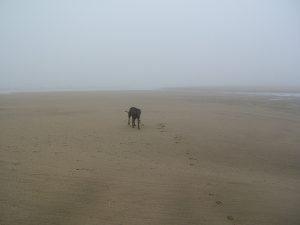
A less bloody end than most Border Ballads.
We thank you. If you love lore and verse, and want to know if and when we cover it, why not sign up to greydogtales.com (all free) using the little box on the top left. Note: This also works if you hate either of those topics, and want to know when to avoid us…
